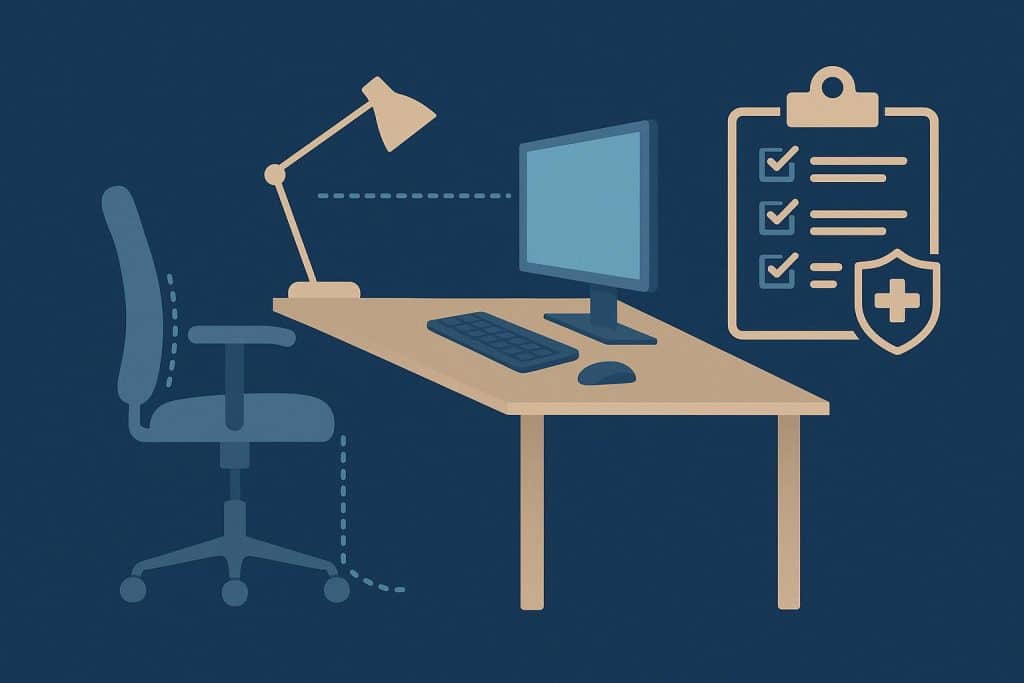When considering workplace safety for your employees, what comes to mind? For many businesses, maintaining a healthy work environment is not just a responsibility but also a smart way to reduce unnecessary costs.
One effective approach to achieving this is through ergonomics. Monitoring and improving how employees work decreases the risk of injuries, leading to fewer claims under a workmen compensation policy. Let’s explore how ergonomics contributes to safer, more comfortable working conditions for all employees.
Understanding the importance of ergonomics
Ergonomics is the science of designing the place of work to fit the needs of the employee. This means that desks, chairs, tools, and tasks are designed to align with the physical needs and capabilities of your employees.
Poor ergonomics can result in back pain, repetitive strain injuries and fatigue—common issues in workplaces where many workers spend long hours at desks or on factory floors. These conditions can lead to claims under a workmen compensation policy, which covers medical expenses and lost wages for affected employees.
A proper ergonomic setup can prevent these issues from ever occurring. For example, raising the height of chairs or ensuring adequate lighting can make all the difference. When your employees feel comfortable in a well-designed workspace, they are less likely to get injured and subsequently file claims. This allows you to foster a healthy and active workforce.
How ergonomics cuts down on injuries
Workplace injuries don’t always stem from major accidents—they often result from small, repetitive actions like typing at an awkward angle or improper lifting techniques. Ergonomics addresses these everyday risks head-on by promoting better work practices. By setting up workstations that support good posture and reduce strain, you can help prevent common issues such as neck pain and wrist injuries for your employees.
Think about a factory worker lifting boxes all day. If they’re taught the right way to lift and given tools like adjustable trolleys, their risk of injury drops significantly.
Boosting employee well-being with ergonomics
A workplace that prioritises ergonomics does more than prevent injuries; it shows your employees that their health matters. When you provide comfortable chairs or breaks to stretch during long shifts, your team feels valued. This can lift their mood and energy levels, making them more engaged in their tasks.
In countries where labour-intensive jobs are common, small changes like anti-slip mats or cushioned flooring can ease physical stress. Happy and healthy employees are unlikely to apply for sick leaves or file insurance claims, creating a positive environment for everyone involved.
What does a workmen’s compensation policy cover?
To understand how ergonomics ties into reducing claims, it is integral to understand what a workmen compensation policy includes. This type of insurance covers employees who have been injured or have fallen sick because of work-related activities. The policy usually covers medical treatment, rehabilitation costs and compensation for temporary or permanent disability.
Some plans also cover occupational issues associated with prolonged exposure to certain environments or conditions, such as hearing loss caused by loud machinery.
Implementing ergonomics to address these risks accordingly will help you reduce claims. For example, providing noise-cancelling headsets could prevent hearing issues, keeping your employee insurance costs in check.
Practical steps to introduce ergonomics
Making your workplace ergonomic doesn’t have to be overwhelming. Follow the following steps:
- Start by assessing how your employees work daily. Are they sitting for hours without proper back support? Are tools placed too high or too low, forcing awkward movements? Simple fixes, like adjustable chairs or footrests, can solve these problems.
- Training your team is equally important. Show them how to sit correctly, lift safely, and take short breaks to stretch. In offices, ensure computer screens are at eye level to avoid neck strain.
These efforts can reduce physical exertion and boost safety, lowering the chances of claims under your workmen compensation policy.
Addressing common doubts
Setting up an ergonomic workplace may seem costly, but the expense is often much lower than the long-term impact of repeated compensation claims. Simple changes, such as rearranging workstations or investing in supportive equipment, are both affordable and durable. Over time, these adjustments contribute to a healthier workforce while reducing workmen compensation policy claims.
Another common concern is the time required for implementation. Fortunately, many ergonomic improvements can be introduced quickly without disrupting daily operations. With careful planning, these changes can be seamlessly integrated, delivering noticeable results sooner than expected.
Conclusion
Ergonomics is an easy way to promote a safer and more comfortable work environment. By focusing on how your employees work, you can reduce injuries and limit claims under your workers’ compensation policy. It is an easy action that encourages a healthier space for everyone involved.
Workers’ compensation acts as an important safety net, but it works best when complemented by smart preventative measures such as ergonomics.
